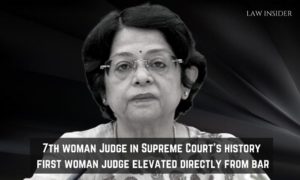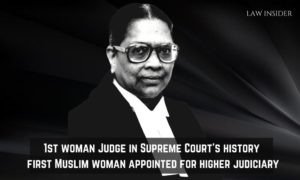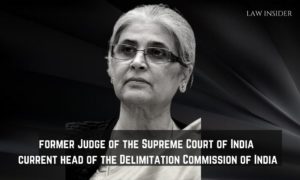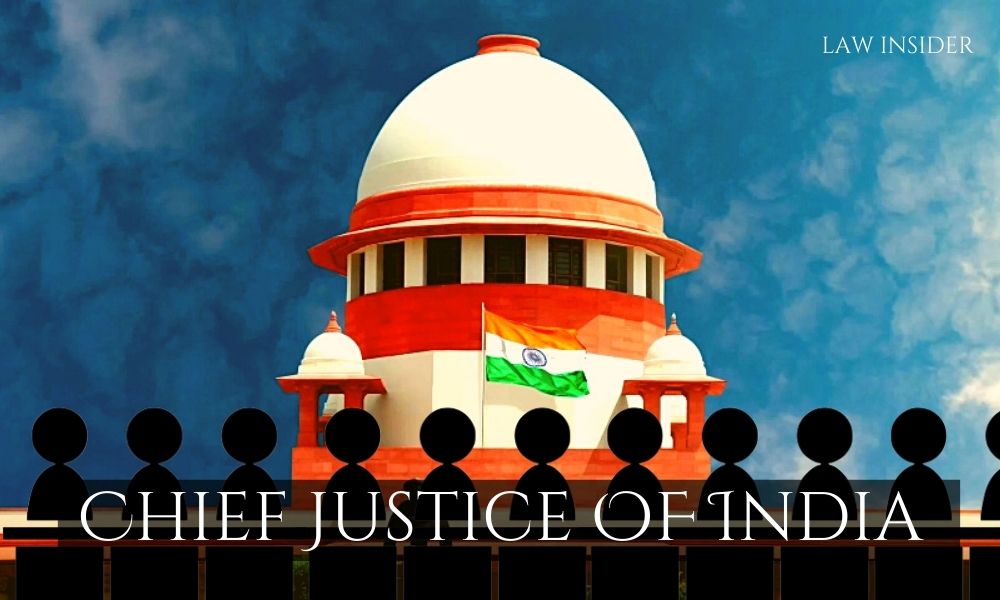By Pooja Bhakar
“I measure the progress of a community by the degree of progress which women have achieved.”- BR Ambedkar
India is a developing country and the same country focusing on Women empowerment as well. Every citizen of India is concern about the development of the nation, gender equality, women empowerment and what not. But sadly nobody ever noticed the female ratio in the Indian Judiciary system until Attorney-General KK Venugopal marked his concern on the need of more women judges.
He said, “Improving the representation of women could also go a long way towards a more balanced and empathetic approaching case involving sexual violence. For instance, this court has only 2 women judges as against a sanctioned strength of 34 Judges. There has never been a female Chief Justice. This figure is consistently low across the higher Judiciary. There are only 80 women judges out of the sanctioned strength if 1113 judges in the High Courts and the Supreme Court”.
Now the most basic and important question arising in the minds of the people is, What is the reason behind never having a female Chief Justice in India?
No one have a perfect and accurate answer to this question. But let’s try to understand the reason behind this and our Judiciary system.
About Supreme Court of India
The Supreme Court of India is the supreme judicial body of India and the highest Court of India under the constitution. It is the most senior constitutional Court, and has the power of judicial review.
Earlier the strength of Judges in Supreme Court was 30 +1(Chief Justice of India). But after the new Supreme Court amendment bill, 2019, passed by Ravi Shankar Prashad. The strength of judges was increased to 33+1 (Chief Justice of India). This means Supreme Court has strength of 34 judges including Chief Justice of India.
The Supreme Court is currently working at strength of 29 Judges against the sanctioned strength of 34 judges.
As of now the Apex Court of India has only one women judge (Justice Indra Banerjee, she will be retiring soon in 2022), after the recent retirement of Justice Indu Malhotra (on 13th March 2021).
Surprisingly, after 75 years of Indian Independence, India has only 8 Women Judges of Supreme Court so far. That too without any one being the Chief Justice of India.
The 8 women judges in Supreme Court till now are-
- Justice Fathima Beevi
- Justice Sujata Manohar
- Justice Ruma Pal
- Justice Gyan Sudha Misra
- Justice Ranjana Desai
- Justice R.Banumathi
- Justice Indu Malhotra
- Justice Indira Banerjee.
Justice Fathima Beevi was first female judge of Supreme Court of India, appointed in 1989. And the second women Judge was Justice Sujata V Manohar, who was elevated to the Supreme Court in 1994. There was a clear gap of 5 years in appointment of any new female judge in Supreme Court.
After this the third woman judge Justice Ruma Pal ,came to the Supreme Court in the year 2000. Again the clear gap of 6 years in appointment of any new female judge in Supreme Court. This data shows the discontinuity and long breaks in appointment of female judges.

Why we have less number of women participation in Indian Judiciary?
The reason for fewer women in Indian Judiciary system has no accurate answer. All the reasons are just based upon the prevailing facts and most probable society situations.
- Sex Ratio in India–
The most basic reason of less number of women participation in Judiciary system is the existing sex ratio of India. According to census 2011, it is found that gender ratio in India is 943 females per 1000 males. In 2020, the sex ratio of total population in India is 108.18 males per 100 females. The percentage of the female population is 48.04 percent compared to 51.96 percent male population. This express that when we already have a low sex ratio of women in our country we can’t expect more participation from the group who is already less in number.
- Less Participation–
Let’s focus upon facts and consider this data of CLAT (Common law Addmission Test) held in 2019, A total of 2,391 candidates who wrote this examination were allotted seats in the first provisional allotment list. Out of these, 1,333 are male and 1058 are female candidates. In simple words, 55.75% of the candidates allotted seats in first list are male. And most importantly, only one girl reached in top ten scorer.
Also women’s representation in the district judge cadre is also not as promising. Among district judges, who were recruited from state Bar Councils via exams, only 12% were women in the 13 states analyzed. The representation was especially low in Jharkhand (1 woman out of 30 district judge appointments), Uttar Pradesh (9/139) and Gujarat (4/57).Now how can anyone expect more number of females in judiciary system after considering this data?
- Societal Constraints–
Though India is a developing country and has made remarkable achievements by women in the country, still the larger part of the society has not accepted woman as a professional and contributor to the society. Women lawyer are labeled as unprofessional. People still but bars for women and not appreciate them for doing anything more than the household work. De-motivating and demoralizing young girls and woman for participating in professional and out of home activities by the society is one of the main reasons behind the less number of females in Judiciary system.
- Lack of Opportunity–
Women in our society are not even provided by the opportunities to grow. The family, society, system still somewhere favors boys/man in every opportunity. Starting from the basic necessities to education to marriage to work profile, everywhere man are given priority to chose and grow. Women always have to work and adjust with the leftovers- and that’s a fact.
- Marriage–
The most important factor responsible for less no. of womens in judiciary is the Marriage. According to the census of 2011, the mean age of marriage of women in India is 21.2 years. And after marriage lot of responsibilities increase on women shoulders. With such an early age of marriage how can women play their role in corporate and judiciary sectors? Even if a girl starts her career in any field as soon as she gets married she will not able to grow more and hence have to quit the job. So, Marriage is the biggest hindrance in the participation of women in Judiciary system.
- Promotion–
In all the states, the post of civil judges (junior division) is filled by direct recruitment. The civil judges (junior division) are promoted as senior civil judges usually based on the principle of merit cum seniority (or seniority cum merit) but sometimes, the promotions are also made on the principle of merit (in Maharashtra).
The senior civil judges are promoted as district judges. Apart from this, the district judges are also directly recruited through a competitive examination. In India there are only Males in judicial collegiums, responsible for promotions and it is one of the reason for less promotions of females as compared to males. As males prefer males to be promoted more.
There are so many infinite reasons we can count on like liberty given to girls, gender equality, lack of political will, lack of will power on part of Judge-makers, etc for the less number of females in Indian Judiciary System. After analyzing some of these points we can think of more on our own.
What Constitution of India speaks about the judges?
Article 124(1) – This article states that there shall be a Supreme Court of India consisting of a Chief Justice of India and, until permanent by law prescribes a large number, of not more than seven other judges.
Article 124(2) – States that every Judge of the Supreme Court shall be appointed by the President by warrant under his hand and seal after consultation with such number of the Judges of Supreme Court and of the High Courts.
Article 124(3) – States that a person shall not be qualified for appointment as a judge of the Supreme Court unless he is a citizen of India and-
- Has been at least 5 years a Judge of High Court or of 2 or more such Courts in succession; or
- Has been for at least 10 years as an Advocate of High Court or of 2 or more such Courts in succession; or
- Is, in opinion of the President, a distinguished Jurist.
Appointment of a Judge in Supreme Court
As we already read about the appointment of judge in Article 124(2) lets understand it in detail.
- Every Judge of the Supreme Court shall be appointed by the President by warrant under his/her hand and seal after consultation with such of the Judges of the Supreme Court and of the High Court in the States as President may deem necessary for the purpose and shall hold office until he attains the age of 65 years.
- Supreme Court held that the consultation with Chief Justice is not binding on the President. But the Court held that consultation should be effective.
- In Supreme Court Advocates-on-Record Association Vs Union of India 1993, the Court states that the view of the CJI is binding on the President, the Court also held that while advising the President CJI is expected to consult two of the senior-most Judges.
- CJI is the sole authority to initiate the process of appointment of Judges of the Supreme Court. In case of conflict of opinion between CJI and President, the view expressed by CJI will have a primary.
- In July 1998, the President sought the Court’s opinion on core issues relating to the appointment of Apex Court Judges and transfer of High Court Judges.
- The 11th Presidential Reference sought clarification on certain doubts over the consultation process to be adopted by the Chief Justice of India as stipulated in the 1993 case relating to judges appointment and transfer opinion.
Tenure of Judges in Supreme Court
The Constitution of India has not fixed the tenure of a Judge of the Supreme Court. However, it makes the following 3 provisions regarding this:
- He holds office until he attains the age of 65 years.
- He can resign his office by writing to the president.
- He can be removed from his office by the president on the recommendation of the Parliament.(By Impeachement)
What is necessary for being a Judge?
Apart from the educational qualification there are many other categories that matters.No doubt females are more intelligent than males. But can we make someone eligible for Judge just on the basis of Intelligence? Of course NO. The other parameters other than educational qualification that matters for being a judge are-
Knowledge–
Level of knowledge required for being a judge is far more than the bookish knowledge. The current affairs awareness, legal awareness, etc. One should have an excellent knowledge in all fields relating to the Judge career.
Personality Development–
Being a lawyer requires a strong and bold personality to stand in Court and deal with the opponent. And girls since beginning are taught to be polite and calm. With this introvert and soft personality it’s very tough for women to be a great lawyer, and hence the number of female lawyers is so low.
Problem Analyzing–
A lawyer must have a quality of analyzing and solving a problem quickly. And this quality is seen less in females as compared to males.
And many more qualities are essential, that we know are found less in females as compared to males.
Status of women in High Court
Bench refers to “Judges” or “panel of Judges”.
The lower Judiciary in India has a mere 27.6 percent woman constituting the current strength of 15,806 judges. Similarly, the women judges in High Courts are abysmally low-around 10percent of its total current strength of 692 judges or just 70 judges. [Data as per February 2020]
The 24 High Courts in the country have only 64 women judges compared to 557 male judges, and there is not a single woman judge in eight High Courts. While at least 44 names were recommended by the Allahabad High Court collegium to the government recently for appointment as judges, only two of them are women.
Presently, Justice Hima Kholi is the only Chief Justice of any Indian High Court. And she will be retiring from Telengana High Court on 1 September 2021. After her retirement sadly there will be no female Chief Justice in any High Court in India..
Recently, the Ministry of Law and Justice of India was asked five questions in the Lok Sabha.
The first three questions were about the number of female judges in the Supreme Court, the High Courts, Tribunals and the subordinate judiciary.
The response was that the details of female Judges in Tribunal and Information and Subordinate Judiciary are not centrally maintained.
Further, the Government was questioned over steps taken to increase the representation of women in judiciary, and consideration on implementing reservations to increase the same.
In response to which, Ravi Shankar Prasad, the Minister of Law and Justice of India, said that the appointments of High Court judges are made under Articles 217 and 224 of the Constitution.
He said, “These Articles do not provide for reservation for any caste or class of person including women. The Government has, however, been requesting the Chief Justices of the High Courts that while sending proposals for appointment of Judges, due consideration be given to suitable candidates belonging to Scheduled Castes, Scheduled Tribes, Other Backward Classes, Minorities and Women,” .
Women Advocates view on this
No one can better describe this situation in judiciary system better than the female Advocates themselves. The inside story can be better known by the following data considered from an interview-
Rucha Anant Pandey –
She started practising at the Nagpur bench of the Bombay High Court a few months ago, says her initiation into the field was in a trial Court in Pune, where she handled criminal cases along with a senior. Everyone in the Court, from the bailiff to the court clerk to male lawyers asked her, “Madam, kya kar rahe ho [What are you doing here]?”, referring to her as a misfit in the world of criminal law. Even, A judge once asked her to call her senior, and advised him to give her only certain kind of cases.
Justice A.P. Shah–
High Court Chief Justice recalls having once recommended a woman lawyer as a judge, but she was rejected apparently because she was ‘rude’. “If a male lawyer replies in a certain manner to a judge, it is usually taken in the stride. But if the same things were to be said by a woman, it becomes a topic of discussion for the bar or bench, and not in a pleasant way,” he says. Shah is known as one of the few High Court Chief Justices to recommend a good number of women for judgeship; many of the names, however, got rejected.
Avani Bansal–
When She started practice in the Supreme Court, recalls how the male lawyers in the trial court used every tactic under the belt to unnerve her—from commenting on her attire to making snide remarks about her Oxford degree to getting outright hostile by yelling at her, ‘Zyada hoshiyari na dikhao [Don’t try to act smart]. She said, “I was one of two or three women in a court where hundreds of lawyers practised, I was an oddity who was stared at, humiliated, who was either an irritant for the male lawyers or a source of amusement. The lawyers were hostile, and the judges never reprimanded them.”
This is not even the 2% view of the inside stories of what women face everyday in the Indian Judicial system. And without any doubt the main reason for less participation of women in the Judiciary syatem.
The reason behind this situation of women in Indian Judiciary system is the same we discussed earlier. And the same facts we are very well aware of.
Why we need women in Judiciary?
Though man can serve the judiciary system too why we still need female judges? Because We need woman judge’s perspective. There are many matters evolving in Court’s which require a female perspective as well. The point of view from women side is equally important in many matters.
Gender Sensitivity-
Gender sensitivity is behaviour that avoids discrimination by understanding and accepting the multiple differences between men and women. It is a way of thinking that fosters respect and compassion for others — regardless of these differences
It is important for the female accused and petitioners to have a female judge, because only a female can understand a female emotions and this is a fact too.
As seen recently in a case at Madhya Pradesh High Court where Madhya Pradesh High Court’s order granting bail to a man accused in a molestation case on a condition that he would tie ‘Rakhi’ to the victim. This bench was headed by Justice A.M. Khanwilkar. Opposing this order a plea was filed by Advocate Aparna Bhat and eight other women lawyers challenging the order by the Madhya Pradesh High Court.
Similarly, A Supreme Court bench headed by Chief Justice of India S A Bobde asked a state government employee, who is facing charges of raping a relative when she was a minor, if he intended to “marry her now”. The accused allegedly raped a schoolgirl and now faces charges under the POSCO (Protection of Children from Sexual Offences) Act, 2012.
These judgements and statements by Judges shows that how desperately we need more number of women Judges to understand the sensitivity of these matters and react accordingly.
Gender Diversity-
Gender diversity is equitable or fair representation of people of different genders. It most commonly refers to an equitable ratio of men and women, but may also include people of non-binary genders. Equal representation of females and males is very important in the court and Judiciary system for fair and understanding judgements (rape, molestation cases).
Solutions
- Make more appointments from bar. This means electing more women Advocates from High Court for qualifying the position of Judge.
Even Justice Indu Malhotra was directly elected from the Bar.
- Distinguished Jurists- this clause should be enhanced. Some brilliant female academics can also be considered for the judge post in Supreme Court. Though this clause has never been exercised in India but it should be exercised now.
- Should encourage women on higher and top level positions in Judiciary system for motivating and changing the nature of the Judiciary system.
Few leading ladies in Indian Judiciary System

Justice Indu Malhotra
She was the 7th woman Judge in Supreme Court’s history. She is also the first woman judge to be elevated directly from bar.
She also authored the third edition of The Law and Practice of Arbitration and Conciliation (2014).
Overe the 3 years as a Supreme Court Judge, Justice Malhotra has delivered a series of remarkable judgements, ranging over varied streams of law. Her Landmark Judgements were-
- Struck down Section 497 (adultery) of the Indian Penal Code as unconstitutional.
- Decriminalization of homosexuality (Sec 377 of IPC).
- Dissenting Judgement in Sabarimala Case (women restricted entry in a temple was allowed by her).

Justice Fathima Beevi
She became the first female Judge to be a part of the Supreme Court of India, and the first Muslim woman to be appointed to any of the higher judiciaries in country.
As the years went by, she remarkably rose through the ranks, serving as the Subordinate Judge of Kerala (1968-72), The Chief Judicial Magistrate (1972-4), the District & Sessions Judge (1974-80), a Judicial Member of the Income Tax Appellate Tribunal (1980-83) and a Justice of the Kerala High Court in 1983.
Through her long career, she handled various sessions and civil cases including those of riot and murder, breaking barriers to enter the pubic space as a decision maker.

Justice Ranjana Desai
Justice Ranjana Prakash Desai is a former Judge of the Supreme Court of India, and the current head of the Delimitation Commission of India.
She was previously a public prosecutor for the State of Maharashtra, and served as a judge on the Bombay High Court before her appointment from the Supreme Court.
Conclusion
After going through all the data and research now we can conclude why India never had a female Chief Justice?
Starting from the basic roots defected from the society to top level management we are aware of the situation prevailing. Still one question remain unanswered i.e. what can we do for this situation? Here’s what we can do-
Strengthening the roots–
Starting from the basic education to improvising the society mentality towards women education is the foremost step that should be taken by us for improving our Judicial System. Government should focus on more girls’ education schemes and promote the education system and importance of education especially in the rural areas. Not only the basic and elementary education but also the scholarships and schemes for higher studies in the field of judiciary. Like- reservation of seats for women, scholarship programmes, internships, etc.
Gender Equality–
It’s claimed by many people and popular personalities that now India don’t believe in gender discrimination and it’s not been practiced now. But the bitter truth is Gender Inequality is still the one of the main reason for less women participation in any field. In every field and task man are preferred over women and given priority. Everyone should treat man and woman equally in every field.
Women Empowerment–
This agenda is running from years but still no one implements it in their basic life routine only on social media and hashtags are available for this. If we are really concerned on this topic and want a change in the society, then we have start practicing it in practical life rather than just on social media.
Internship programme–
Being an Advocate and practicing in the Court is a real challenging job especially for women. Government should starting focusing on the women starting their career in law field and help them by providing stipends, internship programmes ,to boost there morale and there career.
There many other things we can do for our society to grow more in judicial system.
Hence, we are responsible for not having any female Chief Justice in India ever. And now we have to focus on our weakening points and help our Judicial System grow more.
References-
Exam data- barandbench
Women views – The Week

